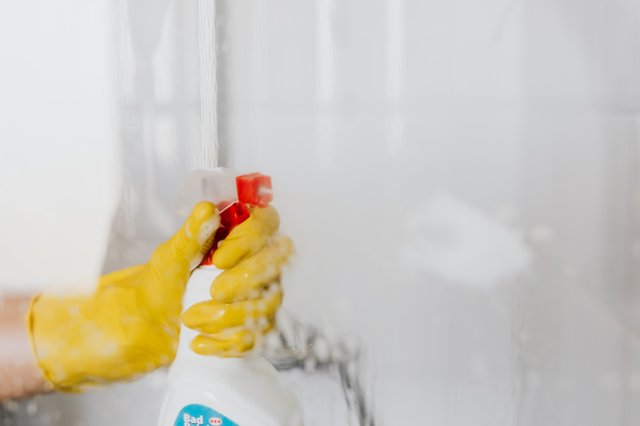by Pride Transport | Aug 31, 2020
In the last few months, the COVID-19 pandemic has truly changed the way we live, work, and do business. Despite what some may say (or desperately wish) this life-threatening virus isn’t going away anytime soon.
For long term eradication the solutions are obvious: government action, testing, and a vaccine. In the meantime there are lots of things we as individuals, truck drivers, and as a community can do to keep ourselves and others safe.
You know the drill: wash your hands often for at least 20 seconds, avoid touching your face, wear a mask, sanitize frequently-touched surfaces, and social distance. (Read more about wearing and making your own mask here).
When you’re on the road it can be difficult to consistently follow all these rules, especially when it comes to sanitizing frequently touched (AKA high-touch) surfaces. It can be dangerously easy to transmit germs you’ve picked up at various stops along your route and the space you’re most likely to impact is the one you’re almost always sitting in.
Think about where you spend the majority of your time. For almost all drivers this place is their cabs. You’re constantly touching the same surfaces in your truck’s cab and sleeper areas that can unfortunately carry and retain tons of germs and bacteria. High-touch surfaces like handles, steering wheel, buttons, and seats are the spots you should be cleaning the most.
Normally it’s recommended to deep clean your cab about twice a month, given the current circumstances however, it’s best to sanitize as frequently as possible. The silver lining to this pandemic? It’s made us all much more aware of our hygiene practices. Consider making cab sanitizing a common routine or habit, even after COVID-19 is old news.
With this in mind let’s dive into the best ways to sanitize your cab and more pro tips on how to stay healthy on the road.
How Is COVID-19 Spread?

Before we get started let’s consider what we know about the coronavirus: basically nothing.
We still don’t know exactly how long it can live on surfaces, whether or not it’s airborne, or even what its long-term health impacts are. Considering the amount of information we don’t know about the virus, it’s recommended to err on the side of caution.
The Centers for Disease Control and Prevention (CDC) states that the primary method of spread is person-to-person via respiratory droplets from sneezing, coughing, and talking. This is why wearing masks and social distancing are so important.
It’s also possible to catch coronavirus, as well as the flu and other viruses by touching a surface that has the virus particles on it, then touching your mouth, nose, or eyes. That’s why frequent hand washing and surface sanitization are crucial.
While nobody knows for sure yet, evidence suggests the virus can remain on surfaces for up to 3 days, especially on glass, steel, and plastic. What’s most frustrating about this is that there’s no clear way to tell if a surface has the virus on it. We can’t just shine a black light and hope to see it. That means it’s better to operate under the assumption that the virus is always present.
When To Clean Your Cab
Forget everything you know about cleaning your cab. That was probably easy, chances are that while you kept your cab clean pre-covid you rarely thoroughly sanitize it. In these times however, you should always aim to go overboard.
In addition to frequently washing your hands, especially when making stops, the best way to keep yourself and others safe is by sanitizing your cab. It’s recommended that you do this daily at the absolute minimum. For high-touch surfaces like door handles, radio, and the steering wheel you should aim to do this every time you re enter your truck.
You should increase this amount when making frequent stops or have visits from DOT or maintenance. Make sure to sanitize your truck’s cab immediately after anyone else has been in your vehicle. It’s also best to make sanitizing high-touch surfaces before you even sit down in a cab a continuous habit.
The Best Sanitizing Formulas

The CDC has laid out a helpful list of products that can kill COVID-19. For your hands use warm water with soap or hand sanitizer if soap and water isn’t available. For your cab’s surfaces reach for spray or disinfectant wipes, bleach, or rubbing alcohol. Ideally the rule of thumb to follow for killing the virus is either 3% peroxide, 70% rubbing alcohol, or a bleach solution of 4 tsp/1 quart cold water.
If you’re unable to find anything of those formulas mix warm water with lots of soap and clean surfaces with that water/soap mixture.
How To Sanitize Your Truck’s Cab
Let get into the nitty gritty of cleaning your truck’s cab. Trust us: it’s not as overwhelming as it may seem. To make the process as easy as possible, schedule in an extra 5-10 minutes before you get into your truck. This is especially important if there have been multiple people in the truck before you.
Use any of the CDC recommended products listed above, though disinfectant wipes are easiest, and start with the most frequently touched spots like door handles (inside and out), steering wheel, gear shift, switches, and windows.
These spots, especially handles and the steering wheel should be sanitized upon reentering your cab, and don’t forget about your keys!
Rub these high-touch surfaces with wipes for at least 15-20 seconds. If you’re using soap and water make sure the water is warm and clean the surface for at least 20 seconds. For a deeper clean wash surfaces with soap and water then go over the surface again with a disinfectant and leave on for a few minutes before wiping dry. It’s recommended to wear disposable gloves while cleaning but even dishwashing gloves will do.
When it comes to cloth materials that cannot be washed or disinfected easily like your seat, carpet, or other fabrics avoid using bleach or hydrogen peroxide as this can damage your cab’s upholstery. Instead, use at least 70% rubbing alcohol with doors or windows open for proper ventilation. To Consider getting a seat cover that can be machine washed.
If you use a sleeper all sheets, linens, and bedding should be washed as often as possible in hot water. Keep this in mind for your clothes too.
When you’re on a route, your cab is your home. Try to keep it as tidy and clean as possible. In addition to sanitizing surfaces and fabrics, this means not leaving food bags, drinks, water bottles, and other outside items inside. This isn’t just to keep things tidy but to rid your cab of any potential germs that may be lingering on these surfaces.
When you’re done cleaning or handling outside objects be sure to wash your hands thoroughly.
Don’t Forget Your Electronics

While you’re sanitizing surfaces in your cab don’t forget about the other touch points you’re always in contact with like phones, radios, CB, tablets, keyboards, shifters, and other electronic devices.
Most electronics can be sanitized with the CDC-recommend 70% rubbing alcohol formula. However you should never apply this disinfectant directly to the device. Instead, soak a bit into a paper towel and thoroughly rub the electronic. As a precaution it’s always best to follow the manufacturer’s cleaning instructions to prevent any damage.
Your Health Is Important
Truck drivers are the lifeblood of the country and this is especially true now. In case we haven’t said it enough thank you drivers. [link to: https://www.pridetransport.com/news-and-events/thank-you-truck-drivers] It’s up to us to keep the country stocked and running smoothly. When it comes to COVID-19 there is no such thing as doing ‘too much.’ You zig-zag around, coming in contact with numerous people and products and it’s vital that you take the proper safety precautions.
With so much responsibility on truck drivers it’s important that you keep yourself healthy and safe. This means getting at least 8 hours of sleep each night and drinking plenty of water. The problem with this advice? It’s nearly impossible to follow while on the road. Long hours, stress, and sleep deprivation are bad enough but they often lead to making poor nutrition decisions and drinking high amounts of caffeine.
The best way to combat that is to take it easy as much as you can when you’re home and off-duty. When you’re on the road try to take vitamins, increase your water intake, and wash your hands as much as possible. We mean seriously get in there, wash your knuckles and under your nails. Wash those hands until they're cracked and dry. Stay safe out there!
For the latest coronavirus updates and more information about protecting yourself and others check out the CDC COVID-19 website here.